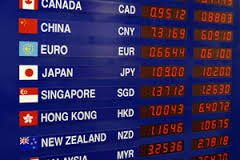The Real Interest Rate Differentials Model indicates that movements in the price of currencies are determined by the levels of interest rates of the countries. Thus, the currencies of countries with high-interest rates should grow in value while the opposite should happen with nations whose interest rates are low.
As we will see below, this model is not able to explain all the movements in the currency market, although much of what happens in the Forex (and in other financial markets) is related directly and indirectly to interest rates.
Bases of the Model
Whenever a country raises its interest rates, international investors discover that the currency of that nation has a higher yield and therefore these investors start buying the currency. This theory was very successful in 2003 when the spreads of interest rates were quite close to the highest levels of the past years.
During that year the data of interest rates in the major economies are:
According to data in the table above, the Australian dollar had the highest spread in basis points and higher returns relative to the U.S. dollar, which certainly confirms the model, as international investors bought the Australian currency and it offered greater benefits. The same can be true for the New Zealand dollar which also had a higher performance compared to the U.S. dollar and increased its value by 27 % compared to this currency. However, the model becomes inaccurate when the U.S. dollar is compared to the euro, as this currency increased its value by 20 % relative to the USD, being the currency that had the largest increase in relation to the U.S. dollar, except for the NZD, despite its basis point differential was only 100 points. The model raises further doubts when the Japanese yen is compared with the British pound. In the case of the yen, the differential is -100, however, this currency rises in value by almost 12% against the dollar. Meanwhile, the pound rose in value by only 11% against the dollar, although it had a very high-interest rate of 275 points.
The model also indicates that one of the key factors to determine the level of response in the price change of a currency to a change in interest rates is the persistence or duration expected for this change. Thus, if it is expected that an increase in interest rates last five years, the effect on the exchange rate of the currency will be much greater than if the rise is expected to last only a year or two.
Limitations of the Real Interest Rate Differentials Model
There is currently a debate among international economists about whether there is a real and truly meaningful relationship between changes in the interest rates of a country and the exchange rate of its currency. The main weakness of this theory is that the current account balance is not taken into account and is based solely on capital flows.
Even, this model tends to over-represent capital flows at the expense of other factors that also have relevance to the exchange rate of a currency, as inflation, political stability, economic growth, and others. In the absence of other factors such as those mentioned above, this model can be useful, as it is logical to conclude that an investor shall direct their capital investment to the instruments that offer higher returns.
In fact, any announcement related to changes in a country’s interest rates, especially in the case of the major economies, can cause effervescence in the markets, especially those news that are related to the currency where there could be an increase or reduction of interest rates. A clear example of this is the FOMC meetings, in which the market remains on the lookout for any indication that the United States could change its interest rates or keep them unchanged.
In conclusion, although interest rates and differentials that occur between countries can not explain each and every move in the Forex market, it is a fact that much of what happens in the long-term and even short-term in this market is precisely due to the interest rates and the variations that occur in them, especially in relation to other countries.






